University Report: Child Labour and SMART Goals Analysis
VerifiedAdded on 2022/12/14
|8
|1952
|427
Report
AI Summary
This report is a comprehensive analysis of child labour, focusing on its impact within supply chains and the application of SMART goals for academic and professional development. The report begins with a reflection on the development of academic skills, including critical thinking, communication, and research abilities, as well as the use of SMART goals for personal and academic improvement. It then delves into the issue of child labour, examining its prevalence, causes, and consequences, particularly within global supply chains. The report considers the arguments for and against banning all forms of child labour, offering recommendations for mitigation and prevention based on the findings. The analysis includes an assessment of the effectiveness of current laws and regulations, along with suggestions for improved monitoring and enforcement. The report emphasizes the need for international cooperation, education, and awareness campaigns to address the multifaceted challenges of child labour. Throughout, the report emphasizes the importance of academic skills such as research, writing, and critical analysis, and their relevance to addressing complex real-world issues.
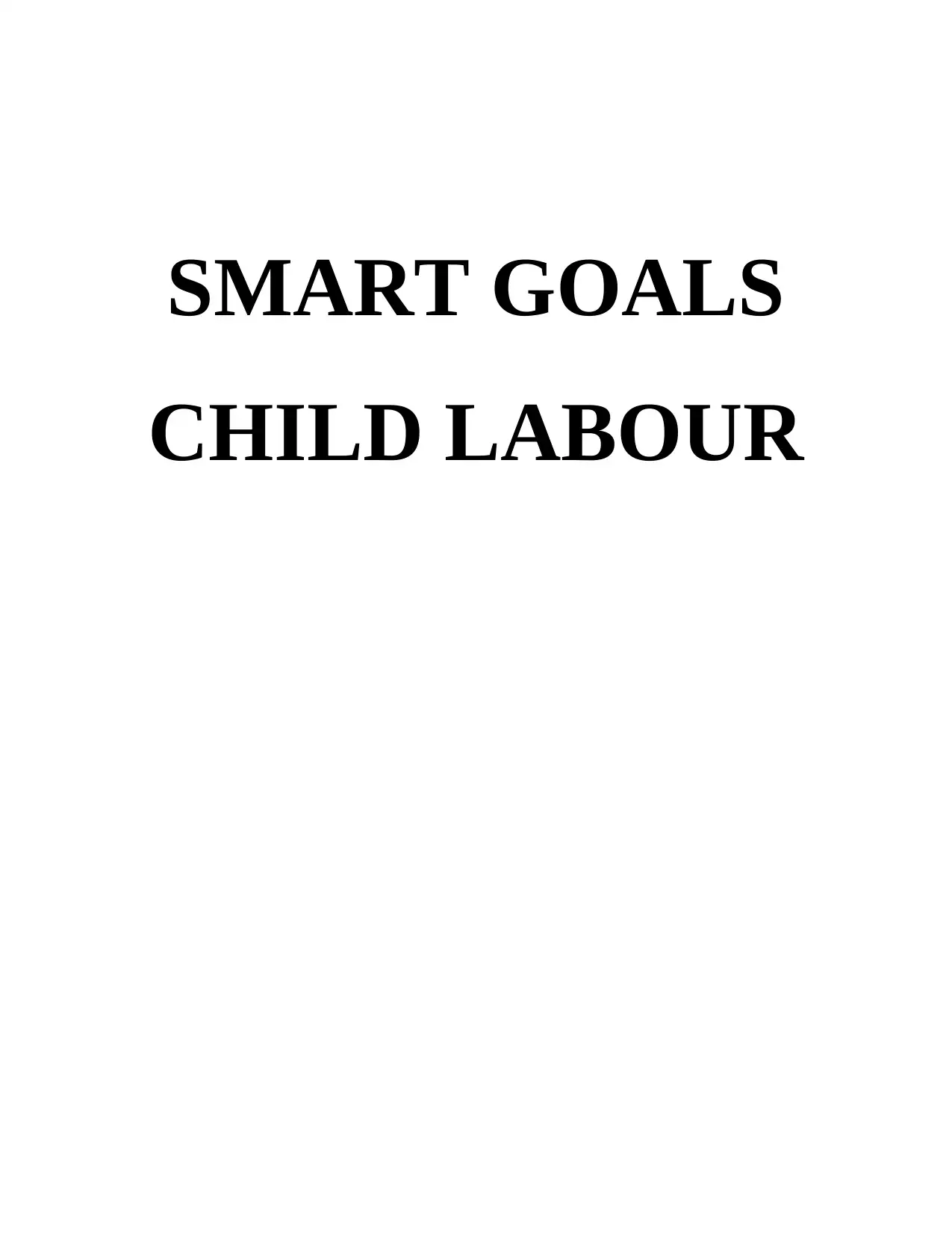
SMART GOALS
CHILD LABOUR
CHILD LABOUR
Paraphrase This Document
Need a fresh take? Get an instant paraphrase of this document with our AI Paraphraser
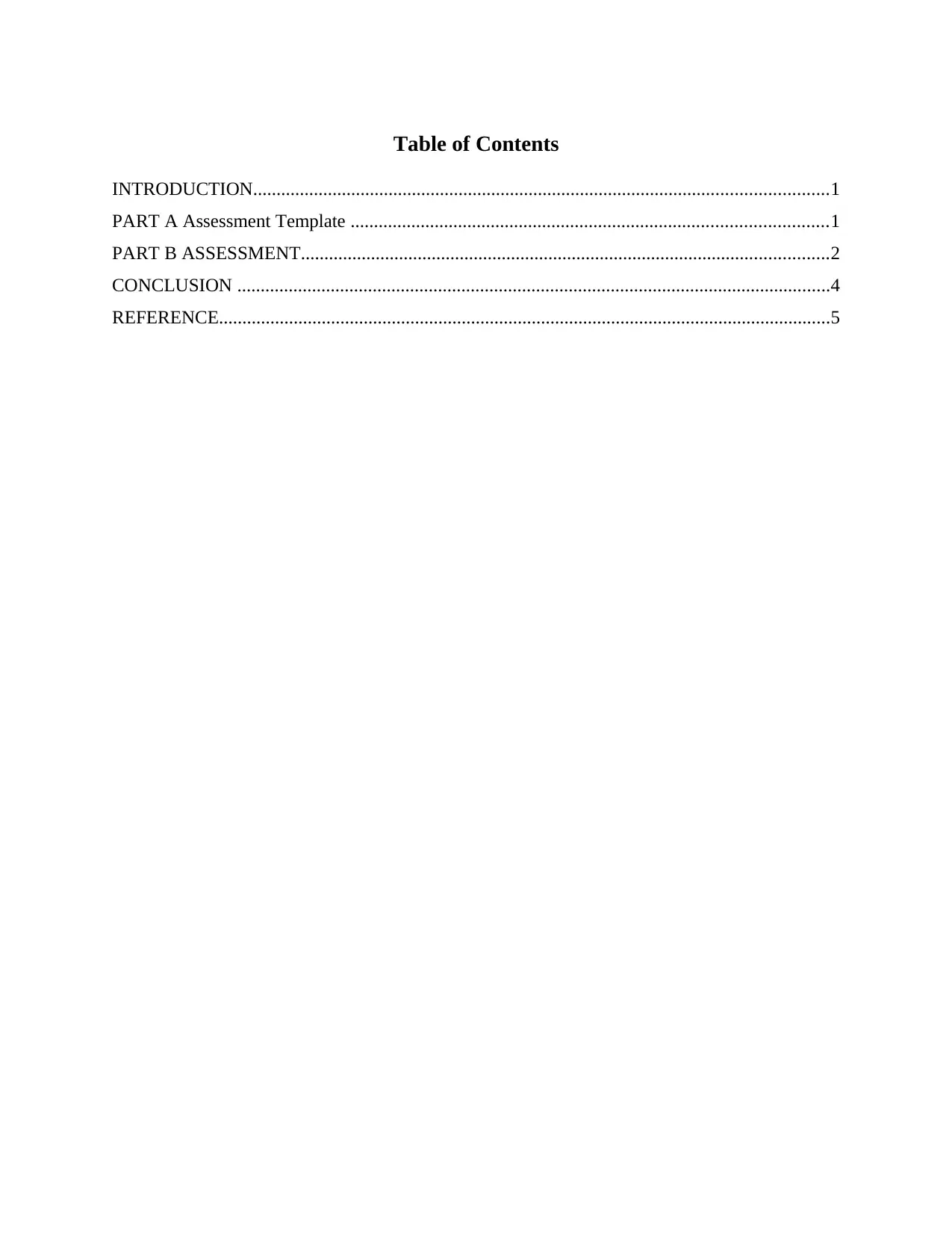
Table of Contents
INTRODUCTION...........................................................................................................................1
PART A Assessment Template ......................................................................................................1
PART B ASSESSMENT.................................................................................................................2
CONCLUSION ...............................................................................................................................4
REFERENCE...................................................................................................................................5
INTRODUCTION...........................................................................................................................1
PART A Assessment Template ......................................................................................................1
PART B ASSESSMENT.................................................................................................................2
CONCLUSION ...............................................................................................................................4
REFERENCE...................................................................................................................................5
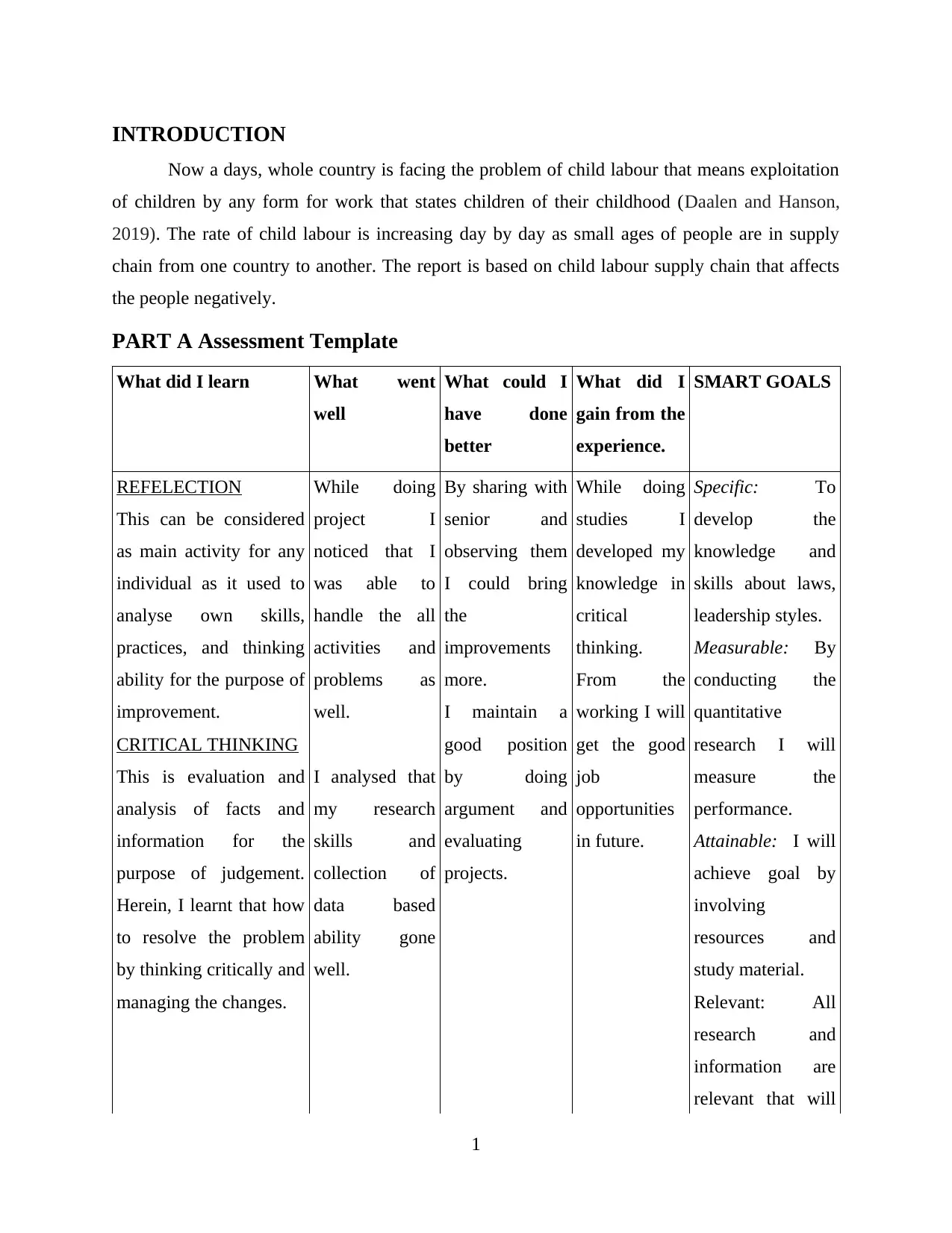
INTRODUCTION
Now a days, whole country is facing the problem of child labour that means exploitation
of children by any form for work that states children of their childhood (Daalen and Hanson,
2019). The rate of child labour is increasing day by day as small ages of people are in supply
chain from one country to another. The report is based on child labour supply chain that affects
the people negatively.
PART A Assessment Template
What did I learn What went
well
What could I
have done
better
What did I
gain from the
experience.
SMART GOALS
REFELECTION
This can be considered
as main activity for any
individual as it used to
analyse own skills,
practices, and thinking
ability for the purpose of
improvement.
CRITICAL THINKING
This is evaluation and
analysis of facts and
information for the
purpose of judgement.
Herein, I learnt that how
to resolve the problem
by thinking critically and
managing the changes.
While doing
project I
noticed that I
was able to
handle the all
activities and
problems as
well.
I analysed that
my research
skills and
collection of
data based
ability gone
well.
By sharing with
senior and
observing them
I could bring
the
improvements
more.
I maintain a
good position
by doing
argument and
evaluating
projects.
While doing
studies I
developed my
knowledge in
critical
thinking.
From the
working I will
get the good
job
opportunities
in future.
Specific: To
develop the
knowledge and
skills about laws,
leadership styles.
Measurable: By
conducting the
quantitative
research I will
measure the
performance.
Attainable: I will
achieve goal by
involving
resources and
study material.
Relevant: All
research and
information are
relevant that will
1
Now a days, whole country is facing the problem of child labour that means exploitation
of children by any form for work that states children of their childhood (Daalen and Hanson,
2019). The rate of child labour is increasing day by day as small ages of people are in supply
chain from one country to another. The report is based on child labour supply chain that affects
the people negatively.
PART A Assessment Template
What did I learn What went
well
What could I
have done
better
What did I
gain from the
experience.
SMART GOALS
REFELECTION
This can be considered
as main activity for any
individual as it used to
analyse own skills,
practices, and thinking
ability for the purpose of
improvement.
CRITICAL THINKING
This is evaluation and
analysis of facts and
information for the
purpose of judgement.
Herein, I learnt that how
to resolve the problem
by thinking critically and
managing the changes.
While doing
project I
noticed that I
was able to
handle the all
activities and
problems as
well.
I analysed that
my research
skills and
collection of
data based
ability gone
well.
By sharing with
senior and
observing them
I could bring
the
improvements
more.
I maintain a
good position
by doing
argument and
evaluating
projects.
While doing
studies I
developed my
knowledge in
critical
thinking.
From the
working I will
get the good
job
opportunities
in future.
Specific: To
develop the
knowledge and
skills about laws,
leadership styles.
Measurable: By
conducting the
quantitative
research I will
measure the
performance.
Attainable: I will
achieve goal by
involving
resources and
study material.
Relevant: All
research and
information are
relevant that will
1
⊘ This is a preview!⊘
Do you want full access?
Subscribe today to unlock all pages.

Trusted by 1+ million students worldwide
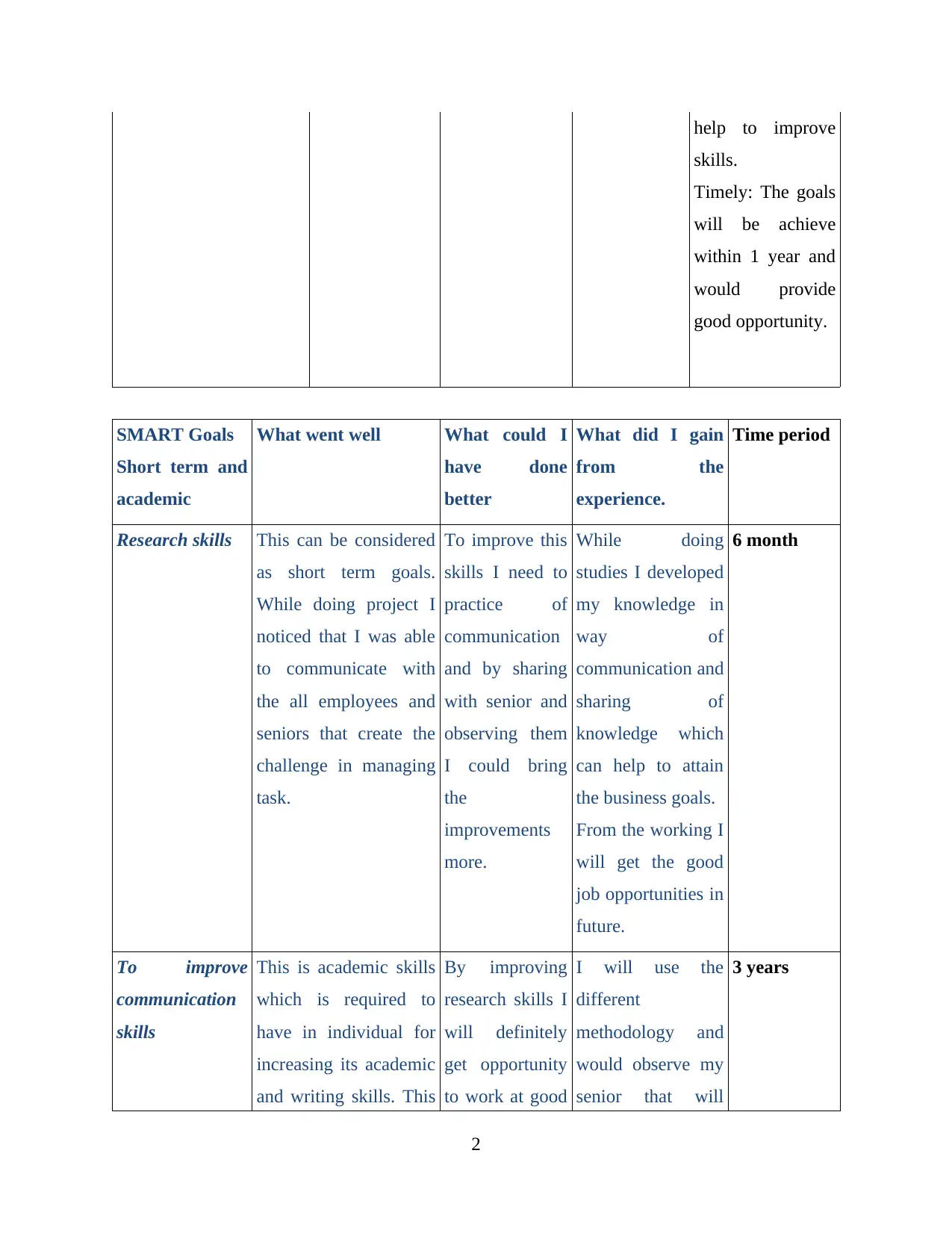
help to improve
skills.
Timely: The goals
will be achieve
within 1 year and
would provide
good opportunity.
SMART Goals
Short term and
academic
What went well What could I
have done
better
What did I gain
from the
experience.
Time period
Research skills This can be considered
as short term goals.
While doing project I
noticed that I was able
to communicate with
the all employees and
seniors that create the
challenge in managing
task.
To improve this
skills I need to
practice of
communication
and by sharing
with senior and
observing them
I could bring
the
improvements
more.
While doing
studies I developed
my knowledge in
way of
communication and
sharing of
knowledge which
can help to attain
the business goals.
From the working I
will get the good
job opportunities in
future.
6 month
To improve
communication
skills
This is academic skills
which is required to
have in individual for
increasing its academic
and writing skills. This
By improving
research skills I
will definitely
get opportunity
to work at good
I will use the
different
methodology and
would observe my
senior that will
3 years
2
skills.
Timely: The goals
will be achieve
within 1 year and
would provide
good opportunity.
SMART Goals
Short term and
academic
What went well What could I
have done
better
What did I gain
from the
experience.
Time period
Research skills This can be considered
as short term goals.
While doing project I
noticed that I was able
to communicate with
the all employees and
seniors that create the
challenge in managing
task.
To improve this
skills I need to
practice of
communication
and by sharing
with senior and
observing them
I could bring
the
improvements
more.
While doing
studies I developed
my knowledge in
way of
communication and
sharing of
knowledge which
can help to attain
the business goals.
From the working I
will get the good
job opportunities in
future.
6 month
To improve
communication
skills
This is academic skills
which is required to
have in individual for
increasing its academic
and writing skills. This
By improving
research skills I
will definitely
get opportunity
to work at good
I will use the
different
methodology and
would observe my
senior that will
3 years
2
Paraphrase This Document
Need a fresh take? Get an instant paraphrase of this document with our AI Paraphraser
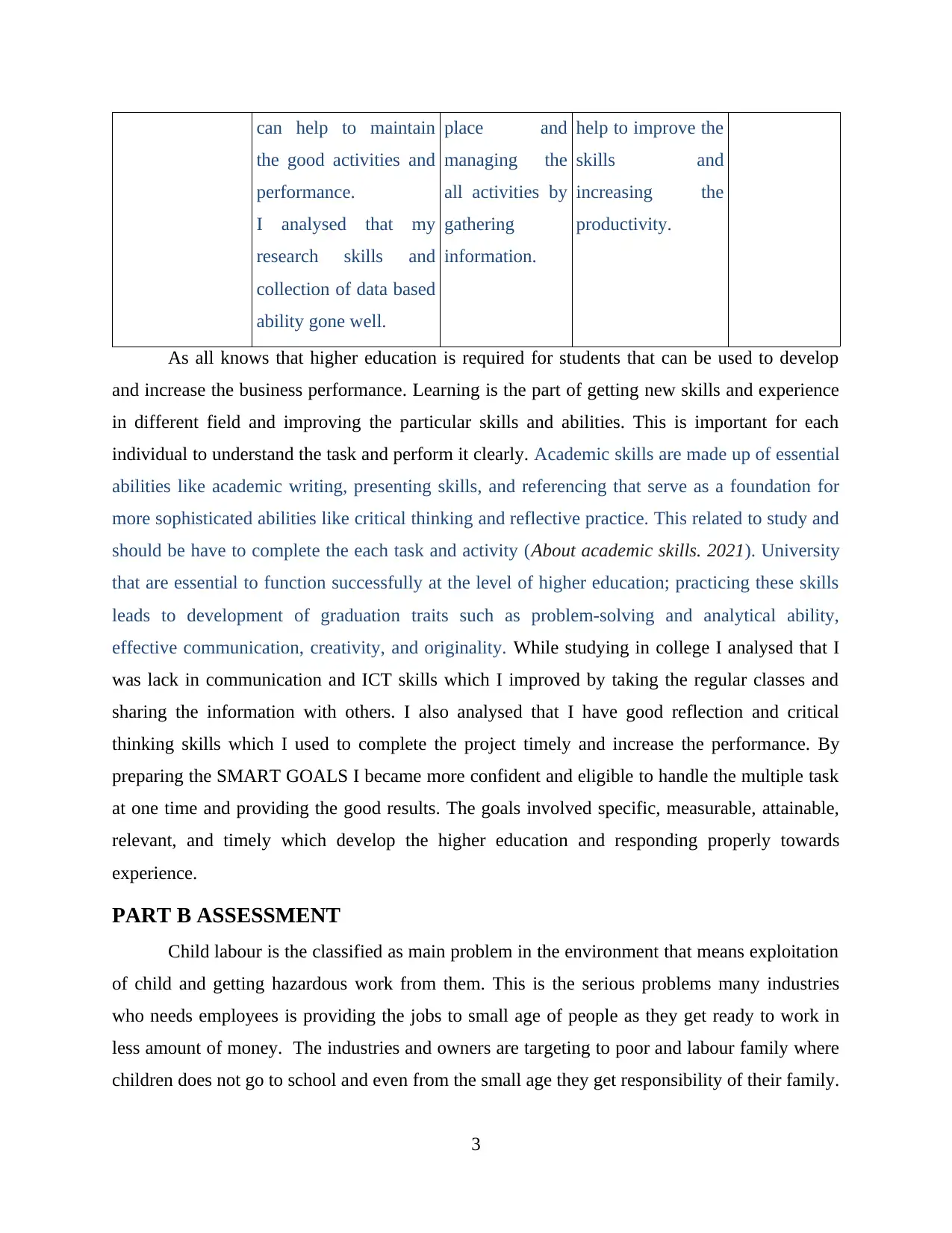
can help to maintain
the good activities and
performance.
I analysed that my
research skills and
collection of data based
ability gone well.
place and
managing the
all activities by
gathering
information.
help to improve the
skills and
increasing the
productivity.
As all knows that higher education is required for students that can be used to develop
and increase the business performance. Learning is the part of getting new skills and experience
in different field and improving the particular skills and abilities. This is important for each
individual to understand the task and perform it clearly. Academic skills are made up of essential
abilities like academic writing, presenting skills, and referencing that serve as a foundation for
more sophisticated abilities like critical thinking and reflective practice. This related to study and
should be have to complete the each task and activity (About academic skills. 2021). University
that are essential to function successfully at the level of higher education; practicing these skills
leads to development of graduation traits such as problem-solving and analytical ability,
effective communication, creativity, and originality. While studying in college I analysed that I
was lack in communication and ICT skills which I improved by taking the regular classes and
sharing the information with others. I also analysed that I have good reflection and critical
thinking skills which I used to complete the project timely and increase the performance. By
preparing the SMART GOALS I became more confident and eligible to handle the multiple task
at one time and providing the good results. The goals involved specific, measurable, attainable,
relevant, and timely which develop the higher education and responding properly towards
experience.
PART B ASSESSMENT
Child labour is the classified as main problem in the environment that means exploitation
of child and getting hazardous work from them. This is the serious problems many industries
who needs employees is providing the jobs to small age of people as they get ready to work in
less amount of money. The industries and owners are targeting to poor and labour family where
children does not go to school and even from the small age they get responsibility of their family.
3
the good activities and
performance.
I analysed that my
research skills and
collection of data based
ability gone well.
place and
managing the
all activities by
gathering
information.
help to improve the
skills and
increasing the
productivity.
As all knows that higher education is required for students that can be used to develop
and increase the business performance. Learning is the part of getting new skills and experience
in different field and improving the particular skills and abilities. This is important for each
individual to understand the task and perform it clearly. Academic skills are made up of essential
abilities like academic writing, presenting skills, and referencing that serve as a foundation for
more sophisticated abilities like critical thinking and reflective practice. This related to study and
should be have to complete the each task and activity (About academic skills. 2021). University
that are essential to function successfully at the level of higher education; practicing these skills
leads to development of graduation traits such as problem-solving and analytical ability,
effective communication, creativity, and originality. While studying in college I analysed that I
was lack in communication and ICT skills which I improved by taking the regular classes and
sharing the information with others. I also analysed that I have good reflection and critical
thinking skills which I used to complete the project timely and increase the performance. By
preparing the SMART GOALS I became more confident and eligible to handle the multiple task
at one time and providing the good results. The goals involved specific, measurable, attainable,
relevant, and timely which develop the higher education and responding properly towards
experience.
PART B ASSESSMENT
Child labour is the classified as main problem in the environment that means exploitation
of child and getting hazardous work from them. This is the serious problems many industries
who needs employees is providing the jobs to small age of people as they get ready to work in
less amount of money. The industries and owners are targeting to poor and labour family where
children does not go to school and even from the small age they get responsibility of their family.
3
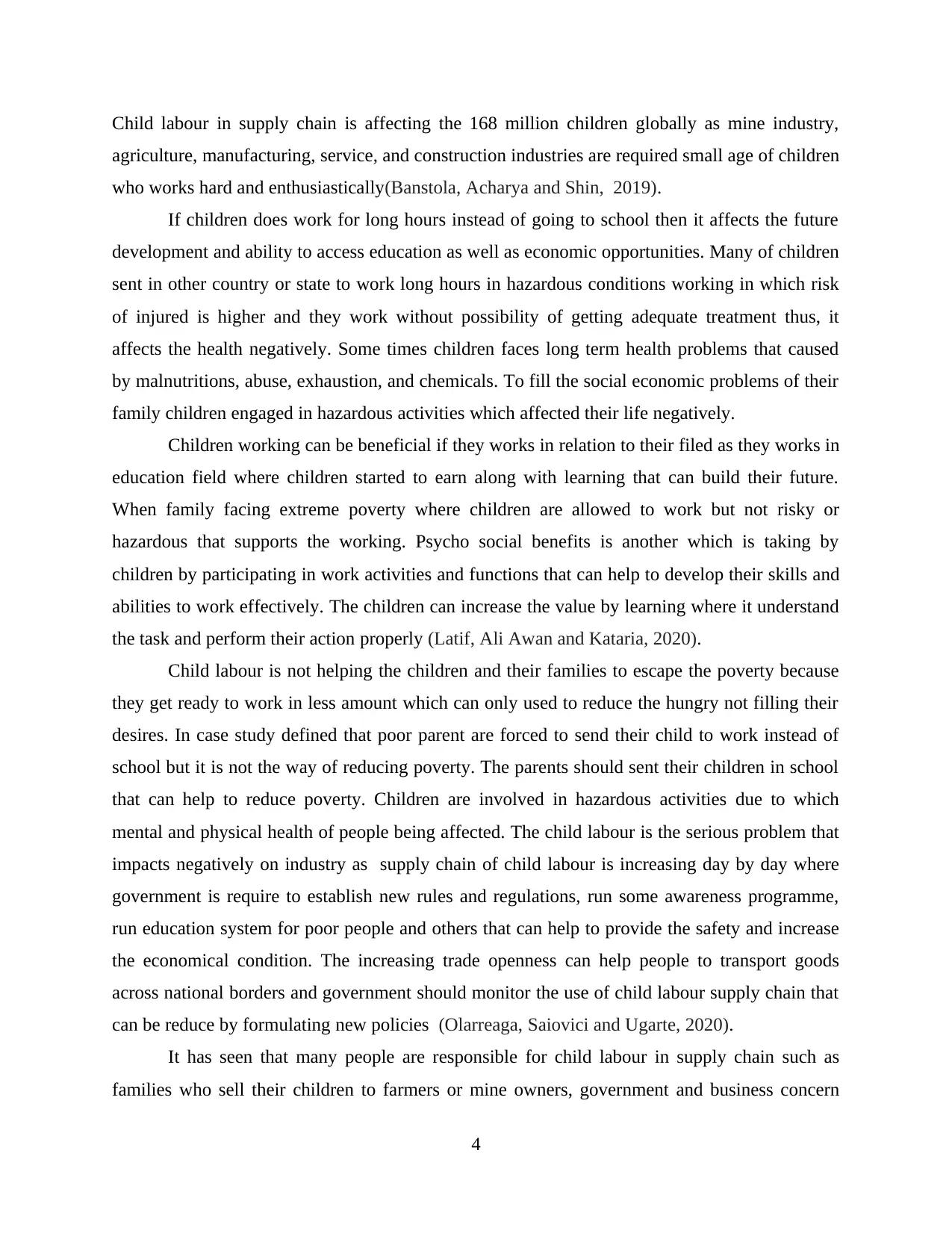
Child labour in supply chain is affecting the 168 million children globally as mine industry,
agriculture, manufacturing, service, and construction industries are required small age of children
who works hard and enthusiastically(Banstola, Acharya and Shin, 2019).
If children does work for long hours instead of going to school then it affects the future
development and ability to access education as well as economic opportunities. Many of children
sent in other country or state to work long hours in hazardous conditions working in which risk
of injured is higher and they work without possibility of getting adequate treatment thus, it
affects the health negatively. Some times children faces long term health problems that caused
by malnutritions, abuse, exhaustion, and chemicals. To fill the social economic problems of their
family children engaged in hazardous activities which affected their life negatively.
Children working can be beneficial if they works in relation to their filed as they works in
education field where children started to earn along with learning that can build their future.
When family facing extreme poverty where children are allowed to work but not risky or
hazardous that supports the working. Psycho social benefits is another which is taking by
children by participating in work activities and functions that can help to develop their skills and
abilities to work effectively. The children can increase the value by learning where it understand
the task and perform their action properly (Latif, Ali Awan and Kataria, 2020).
Child labour is not helping the children and their families to escape the poverty because
they get ready to work in less amount which can only used to reduce the hungry not filling their
desires. In case study defined that poor parent are forced to send their child to work instead of
school but it is not the way of reducing poverty. The parents should sent their children in school
that can help to reduce poverty. Children are involved in hazardous activities due to which
mental and physical health of people being affected. The child labour is the serious problem that
impacts negatively on industry as supply chain of child labour is increasing day by day where
government is require to establish new rules and regulations, run some awareness programme,
run education system for poor people and others that can help to provide the safety and increase
the economical condition. The increasing trade openness can help people to transport goods
across national borders and government should monitor the use of child labour supply chain that
can be reduce by formulating new policies (Olarreaga, Saiovici and Ugarte, 2020).
It has seen that many people are responsible for child labour in supply chain such as
families who sell their children to farmers or mine owners, government and business concern
4
agriculture, manufacturing, service, and construction industries are required small age of children
who works hard and enthusiastically(Banstola, Acharya and Shin, 2019).
If children does work for long hours instead of going to school then it affects the future
development and ability to access education as well as economic opportunities. Many of children
sent in other country or state to work long hours in hazardous conditions working in which risk
of injured is higher and they work without possibility of getting adequate treatment thus, it
affects the health negatively. Some times children faces long term health problems that caused
by malnutritions, abuse, exhaustion, and chemicals. To fill the social economic problems of their
family children engaged in hazardous activities which affected their life negatively.
Children working can be beneficial if they works in relation to their filed as they works in
education field where children started to earn along with learning that can build their future.
When family facing extreme poverty where children are allowed to work but not risky or
hazardous that supports the working. Psycho social benefits is another which is taking by
children by participating in work activities and functions that can help to develop their skills and
abilities to work effectively. The children can increase the value by learning where it understand
the task and perform their action properly (Latif, Ali Awan and Kataria, 2020).
Child labour is not helping the children and their families to escape the poverty because
they get ready to work in less amount which can only used to reduce the hungry not filling their
desires. In case study defined that poor parent are forced to send their child to work instead of
school but it is not the way of reducing poverty. The parents should sent their children in school
that can help to reduce poverty. Children are involved in hazardous activities due to which
mental and physical health of people being affected. The child labour is the serious problem that
impacts negatively on industry as supply chain of child labour is increasing day by day where
government is require to establish new rules and regulations, run some awareness programme,
run education system for poor people and others that can help to provide the safety and increase
the economical condition. The increasing trade openness can help people to transport goods
across national borders and government should monitor the use of child labour supply chain that
can be reduce by formulating new policies (Olarreaga, Saiovici and Ugarte, 2020).
It has seen that many people are responsible for child labour in supply chain such as
families who sell their children to farmers or mine owners, government and business concern
4
⊘ This is a preview!⊘
Do you want full access?
Subscribe today to unlock all pages.

Trusted by 1+ million students worldwide
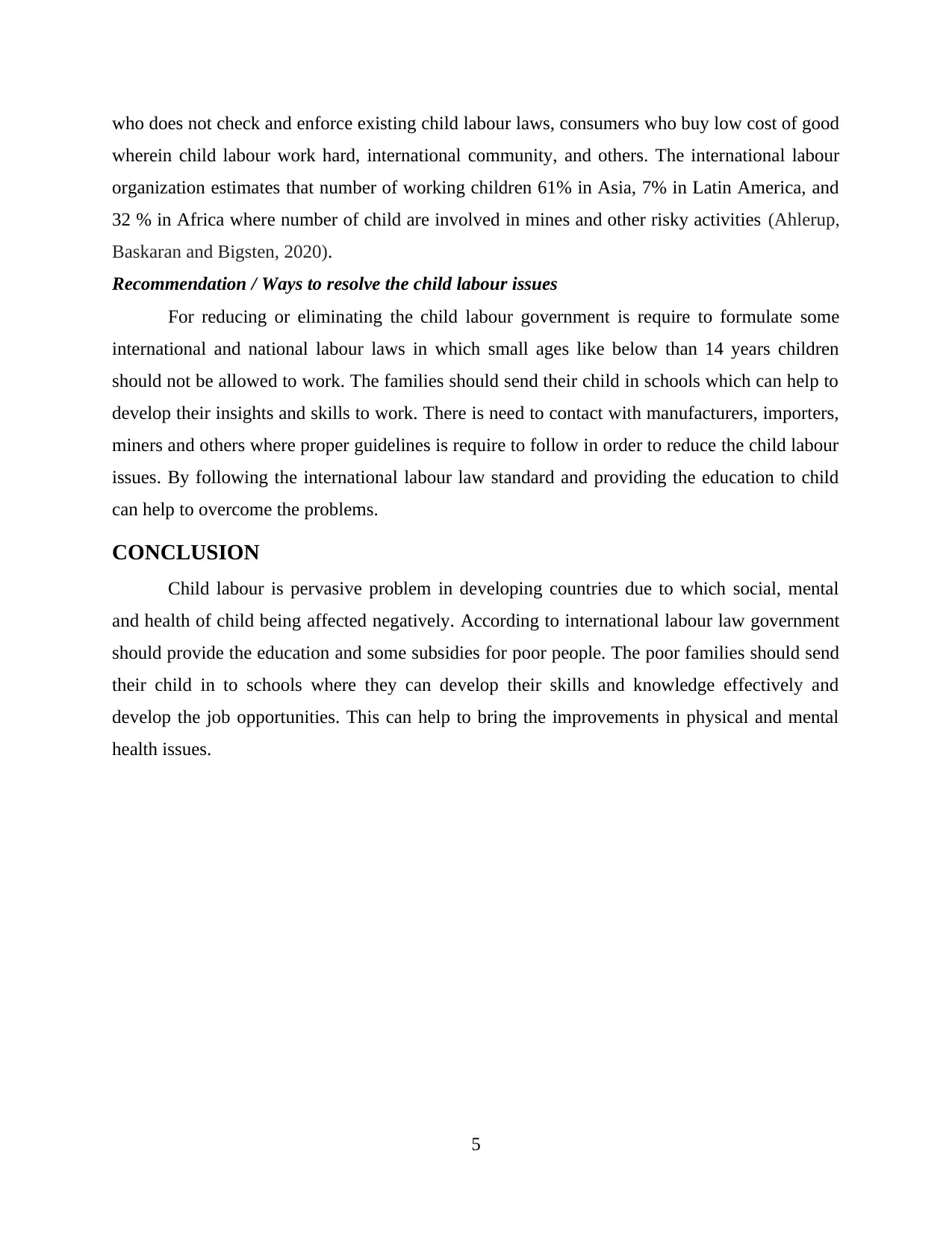
who does not check and enforce existing child labour laws, consumers who buy low cost of good
wherein child labour work hard, international community, and others. The international labour
organization estimates that number of working children 61% in Asia, 7% in Latin America, and
32 % in Africa where number of child are involved in mines and other risky activities (Ahlerup,
Baskaran and Bigsten, 2020).
Recommendation / Ways to resolve the child labour issues
For reducing or eliminating the child labour government is require to formulate some
international and national labour laws in which small ages like below than 14 years children
should not be allowed to work. The families should send their child in schools which can help to
develop their insights and skills to work. There is need to contact with manufacturers, importers,
miners and others where proper guidelines is require to follow in order to reduce the child labour
issues. By following the international labour law standard and providing the education to child
can help to overcome the problems.
CONCLUSION
Child labour is pervasive problem in developing countries due to which social, mental
and health of child being affected negatively. According to international labour law government
should provide the education and some subsidies for poor people. The poor families should send
their child in to schools where they can develop their skills and knowledge effectively and
develop the job opportunities. This can help to bring the improvements in physical and mental
health issues.
5
wherein child labour work hard, international community, and others. The international labour
organization estimates that number of working children 61% in Asia, 7% in Latin America, and
32 % in Africa where number of child are involved in mines and other risky activities (Ahlerup,
Baskaran and Bigsten, 2020).
Recommendation / Ways to resolve the child labour issues
For reducing or eliminating the child labour government is require to formulate some
international and national labour laws in which small ages like below than 14 years children
should not be allowed to work. The families should send their child in schools which can help to
develop their insights and skills to work. There is need to contact with manufacturers, importers,
miners and others where proper guidelines is require to follow in order to reduce the child labour
issues. By following the international labour law standard and providing the education to child
can help to overcome the problems.
CONCLUSION
Child labour is pervasive problem in developing countries due to which social, mental
and health of child being affected negatively. According to international labour law government
should provide the education and some subsidies for poor people. The poor families should send
their child in to schools where they can develop their skills and knowledge effectively and
develop the job opportunities. This can help to bring the improvements in physical and mental
health issues.
5
Paraphrase This Document
Need a fresh take? Get an instant paraphrase of this document with our AI Paraphraser
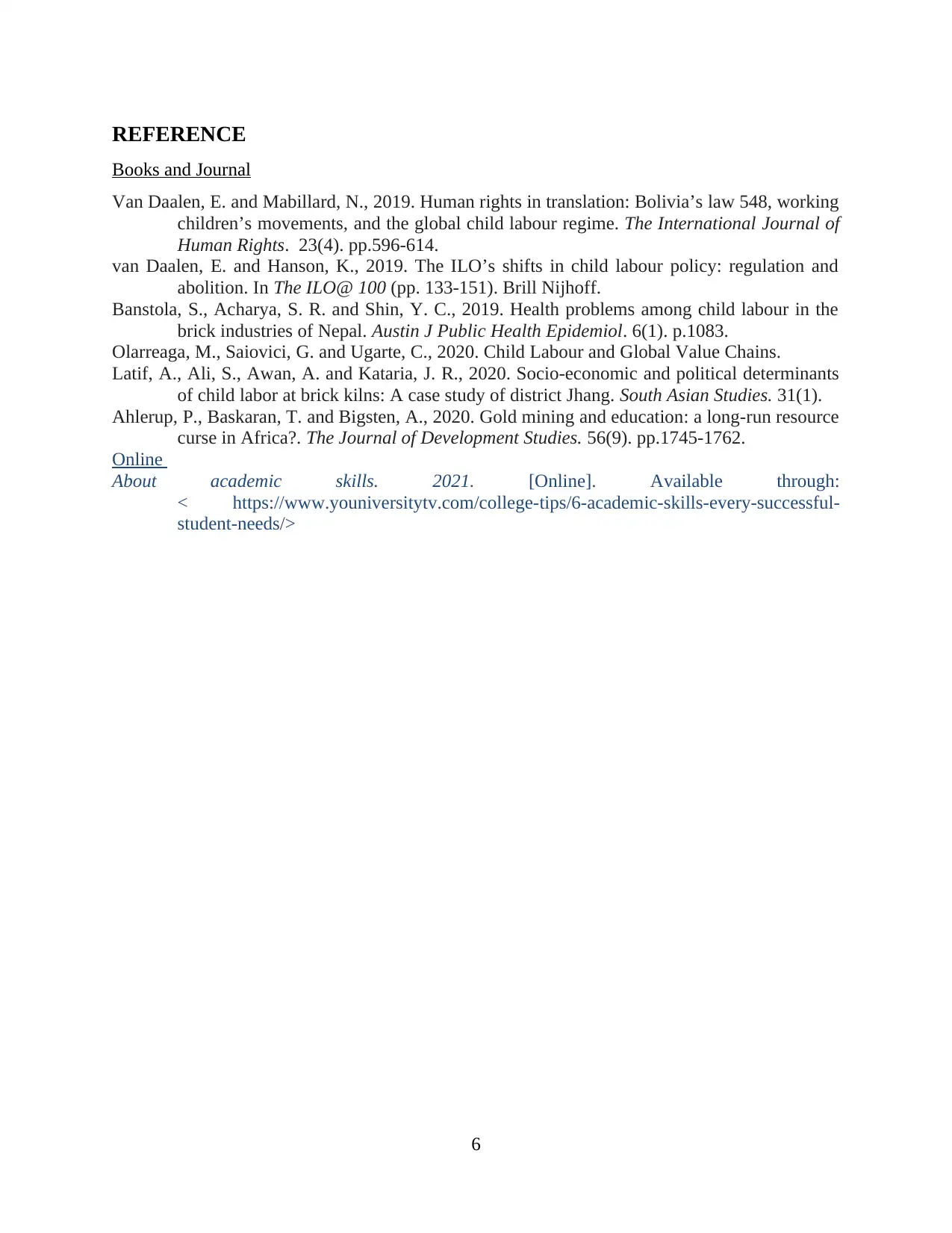
REFERENCE
Books and Journal
Van Daalen, E. and Mabillard, N., 2019. Human rights in translation: Bolivia’s law 548, working
children’s movements, and the global child labour regime. The International Journal of
Human Rights. 23(4). pp.596-614.
van Daalen, E. and Hanson, K., 2019. The ILO’s shifts in child labour policy: regulation and
abolition. In The ILO@ 100 (pp. 133-151). Brill Nijhoff.
Banstola, S., Acharya, S. R. and Shin, Y. C., 2019. Health problems among child labour in the
brick industries of Nepal. Austin J Public Health Epidemiol. 6(1). p.1083.
Olarreaga, M., Saiovici, G. and Ugarte, C., 2020. Child Labour and Global Value Chains.
Latif, A., Ali, S., Awan, A. and Kataria, J. R., 2020. Socio-economic and political determinants
of child labor at brick kilns: A case study of district Jhang. South Asian Studies. 31(1).
Ahlerup, P., Baskaran, T. and Bigsten, A., 2020. Gold mining and education: a long-run resource
curse in Africa?. The Journal of Development Studies. 56(9). pp.1745-1762.
Online
About academic skills. 2021. [Online]. Available through:
< https://www.youniversitytv.com/college-tips/6-academic-skills-every-successful-
student-needs/>
6
Books and Journal
Van Daalen, E. and Mabillard, N., 2019. Human rights in translation: Bolivia’s law 548, working
children’s movements, and the global child labour regime. The International Journal of
Human Rights. 23(4). pp.596-614.
van Daalen, E. and Hanson, K., 2019. The ILO’s shifts in child labour policy: regulation and
abolition. In The ILO@ 100 (pp. 133-151). Brill Nijhoff.
Banstola, S., Acharya, S. R. and Shin, Y. C., 2019. Health problems among child labour in the
brick industries of Nepal. Austin J Public Health Epidemiol. 6(1). p.1083.
Olarreaga, M., Saiovici, G. and Ugarte, C., 2020. Child Labour and Global Value Chains.
Latif, A., Ali, S., Awan, A. and Kataria, J. R., 2020. Socio-economic and political determinants
of child labor at brick kilns: A case study of district Jhang. South Asian Studies. 31(1).
Ahlerup, P., Baskaran, T. and Bigsten, A., 2020. Gold mining and education: a long-run resource
curse in Africa?. The Journal of Development Studies. 56(9). pp.1745-1762.
Online
About academic skills. 2021. [Online]. Available through:
< https://www.youniversitytv.com/college-tips/6-academic-skills-every-successful-
student-needs/>
6
1 out of 8
Related Documents
Your All-in-One AI-Powered Toolkit for Academic Success.
+13062052269
info@desklib.com
Available 24*7 on WhatsApp / Email
![[object Object]](/_next/static/media/star-bottom.7253800d.svg)
Unlock your academic potential
Copyright © 2020–2025 A2Z Services. All Rights Reserved. Developed and managed by ZUCOL.





